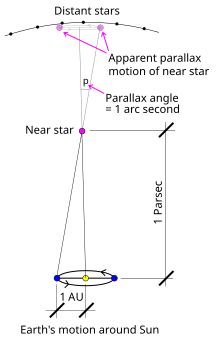
Back اختلاف المنظر النجمي Arabic নক্ষত্র লম্বন Bengali/Bangla Paralaje estelar Spanish Izar-paralaxia Basque اختلاف منظر ستارهای Persian Parallaxe stellaire French Parallax kpakpando IG 年周視差 Japanese Жылдық параллакс Kazakh 연주 시차 Korean

Stellar parallax is the apparent shift of position (parallax) of any nearby star (or other object) against the background of distant stars. By extension, it is a method for determining the distance to the star through trigonometry, the stellar parallax method. Created by the different orbital positions of Earth, the extremely small observed shift is largest at time intervals of about six months, when Earth arrives at opposite sides of the Sun in its orbit, giving a baseline distance of about two astronomical units between observations. The parallax itself is considered to be half of this maximum, about equivalent to the observational shift that would occur due to the different positions of Earth and the Sun, a baseline of one astronomical unit (AU).
Stellar parallax is so difficult to detect that its existence was the subject of much debate in astronomy for hundreds of years. Thomas Henderson, Friedrich Georg Wilhelm von Struve, and Friedrich Bessel made first successful parallax measurements in 1832–1838, for the stars Alpha Centauri, Vega, and 61 Cygni.
© MMXXIII Rich X Search. We shall prevail. All rights reserved. Rich X Search